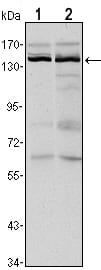KDM3A Primary Antibody
This gene encodes a zinc finger protein that contains a jumonji domain and may play a role in hormone-dependent transcriptional activation. JMJD1A functions as a mono- and dimethylation-specific demethylase, binding iron and alpha-ketoglutarate as cofactors and demethylating Lysine 9 of Histone H3. This suggests that JMJD1A plays a central role in the histone code and participates in nuclear hormone receptor-based transcriptional regulation. In addition, JMJD1A plays an important role in the regulation of cell growth during development and in chromatin regulation. JMJD1A directly regulates the expression of TNP1 and Protamine 1 (proteins required for the proper packaging and condensation of sperm chromatin) and, therefore, plays an essential role in spermatogenesis.
2. Proc Natl Acad Sci U S A.2004 Aug 17;101(33):12130-5.
3. Nature. 2005 Apr 7;434(7034):724-31.



